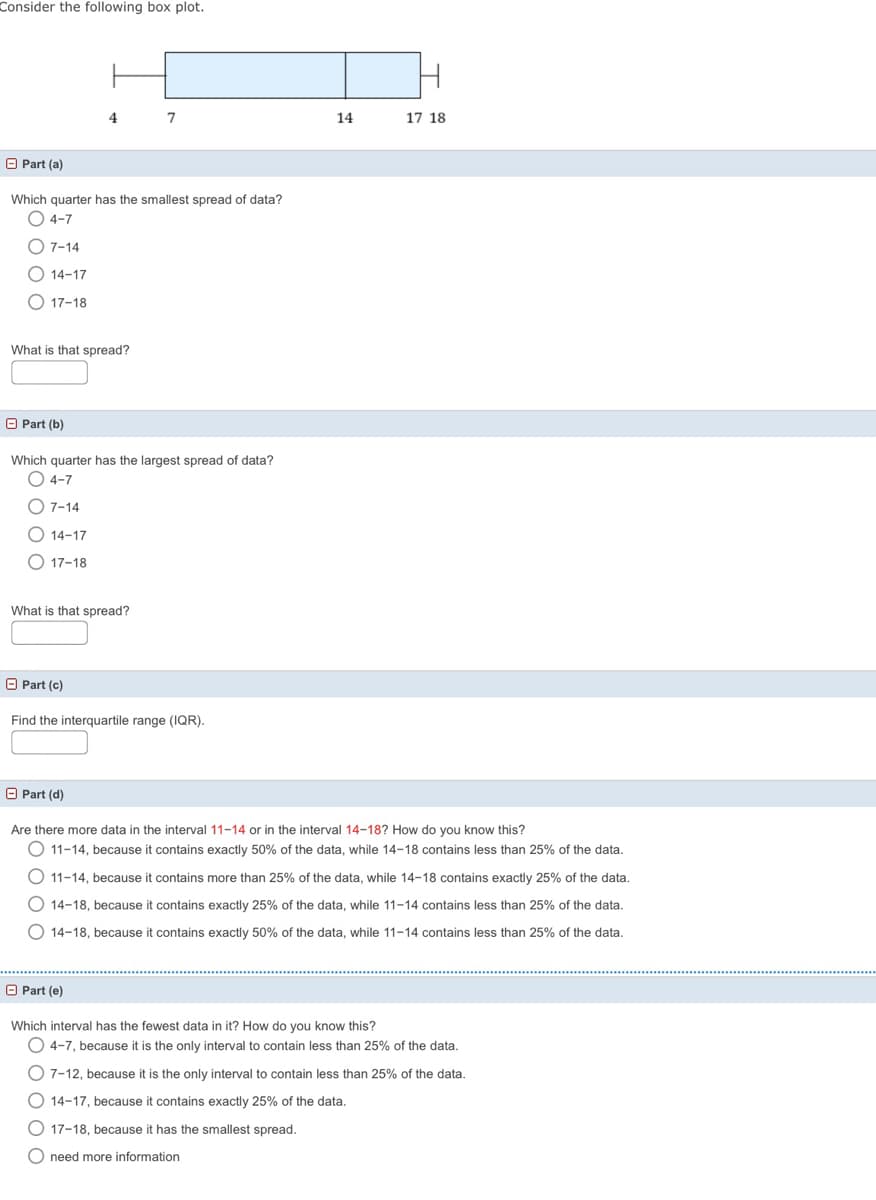4 7 14 17 18 O Part (a) Which quarter has the smallest spread of data? O 4-7 O7-14 O 14-17 O 17-18 What is that spread? O Part (b) Which quarter has the largest spread of data? O 4-7 O 7-14 14-17 O 17-18 What is that spread? O Part (c) Find the interguartile range (IOR)
4 7 14 17 18 O Part (a) Which quarter has the smallest spread of data? O 4-7 O7-14 O 14-17 O 17-18 What is that spread? O Part (b) Which quarter has the largest spread of data? O 4-7 O 7-14 14-17 O 17-18 What is that spread? O Part (c) Find the interguartile range (IOR)
Glencoe Algebra 1, Student Edition, 9780079039897, 0079039898, 2018
18th Edition
ISBN:9780079039897
Author:Carter
Publisher:Carter
Chapter10: Statistics
Section10.4: Distributions Of Data
Problem 20PFA
Related questions
Question

Transcribed Image Text:Consider the following box plot.
4
7
14
17 18
O Part (a)
Which quarter has the smallest spread of data?
O 4-7
O 7-14
O 14-17
O 17-18
What is that spread?
O Part (b)
Which quarter has the largest spread of data?
O 4-7
O 7-14
O 14-17
O 17-18
What is that spread?
O Part (c)
Find the interquartile range (1QR).
O Part (d)
Are there more data in the interval 11-14 or in the interval 14-18? How do you know this?
O 11-14, because it contains exactly 50% of the data, while 14-18 contains less than 25% of the data.
O 11-14, because it contains more than 25% of the data, while 14-18 contains exactly 25% of the data.
O 14-18, because it contains exactly 25% of the data, while 11-14 contains less than 25% of the data.
O 14-18, because it contains exactly 50% of the data, while 11-14 contains less than 25% of the data.
O Part (e)
Which interval has the fewest data in it? How do you know this?
O 4-7, because it is the only interval to contain less than 25% of the data.
O 7-12, because it is the only interval to contain less than 25% of the data.
O 14-17, because it contains exactly 25% of the data.
O 17-18, because it has the smallest spread.
O need more information
Expert Solution
This question has been solved!
Explore an expertly crafted, step-by-step solution for a thorough understanding of key concepts.
This is a popular solution!
Trending now
This is a popular solution!
Step by step
Solved in 3 steps

Recommended textbooks for you

Glencoe Algebra 1, Student Edition, 9780079039897…
Algebra
ISBN:
9780079039897
Author:
Carter
Publisher:
McGraw Hill

Big Ideas Math A Bridge To Success Algebra 1: Stu…
Algebra
ISBN:
9781680331141
Author:
HOUGHTON MIFFLIN HARCOURT
Publisher:
Houghton Mifflin Harcourt

Holt Mcdougal Larson Pre-algebra: Student Edition…
Algebra
ISBN:
9780547587776
Author:
HOLT MCDOUGAL
Publisher:
HOLT MCDOUGAL

Glencoe Algebra 1, Student Edition, 9780079039897…
Algebra
ISBN:
9780079039897
Author:
Carter
Publisher:
McGraw Hill

Big Ideas Math A Bridge To Success Algebra 1: Stu…
Algebra
ISBN:
9781680331141
Author:
HOUGHTON MIFFLIN HARCOURT
Publisher:
Houghton Mifflin Harcourt

Holt Mcdougal Larson Pre-algebra: Student Edition…
Algebra
ISBN:
9780547587776
Author:
HOLT MCDOUGAL
Publisher:
HOLT MCDOUGAL

Functions and Change: A Modeling Approach to Coll…
Algebra
ISBN:
9781337111348
Author:
Bruce Crauder, Benny Evans, Alan Noell
Publisher:
Cengage Learning